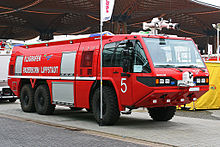Aircraft rescue and firefighting
Due to the nature of a mass casualty incident, rescue workers employ triage to classify the victims and direct their efforts where they can maximize survival.
Specialized fire apparatus are required for the ARFF function, the design of which is predicated on many factors but primarily: speed, water-carrying capacity, off-road performance, and agent discharge rates.
They also must wear self-contained breathing apparatus to provide a source of clean air, enabling them to work in the presence of smoke or other super-heated gases, such as when making entry into the burning cabin of an aircraft.
The Federal Aviation Administration (FAA) mandates ARFF operations at all U.S. airports that serve scheduled passenger air carriers.
In many cases the FAA will perform the investigatory duties after an incident, but in instances where significant injuries or any fatal accident the National Transportation Safety Board (NTSB) will investigate and the ARFF contingent will assist where needed.
An index is assigned to each FAA Part 139 certificate holder based on a combination of the air carrier aircraft length and the average number of daily departures.





